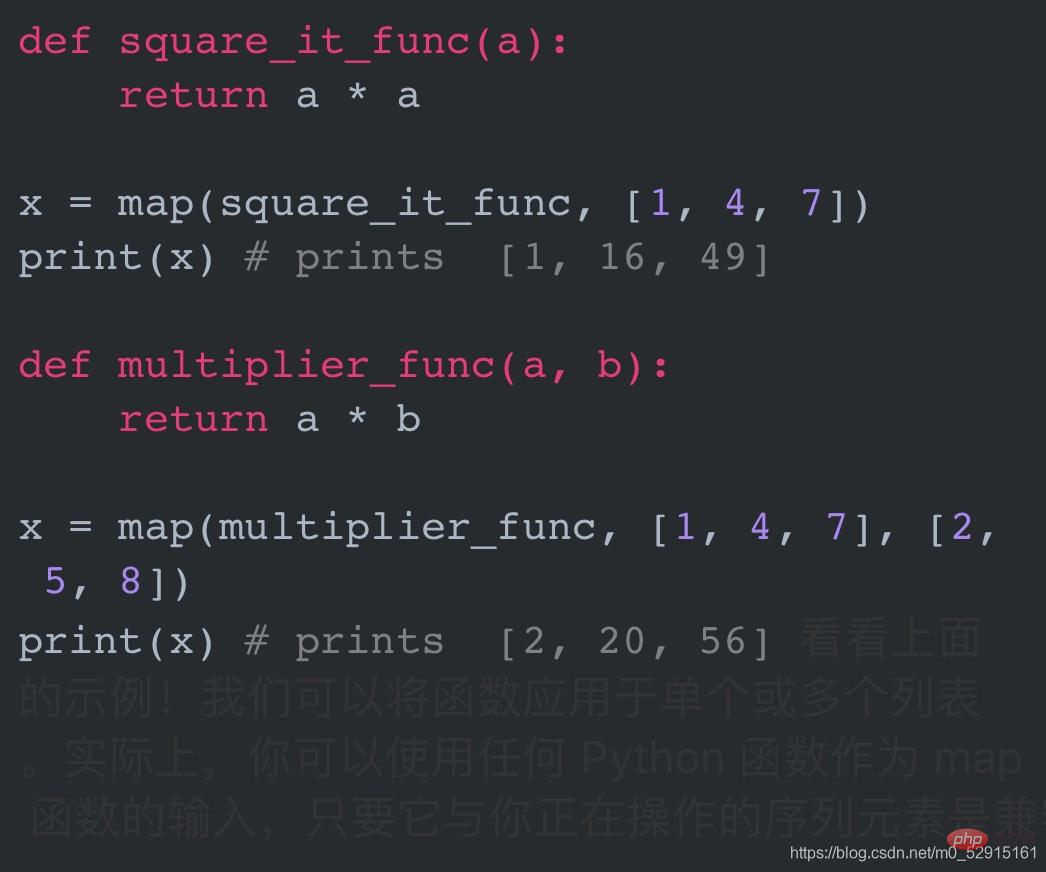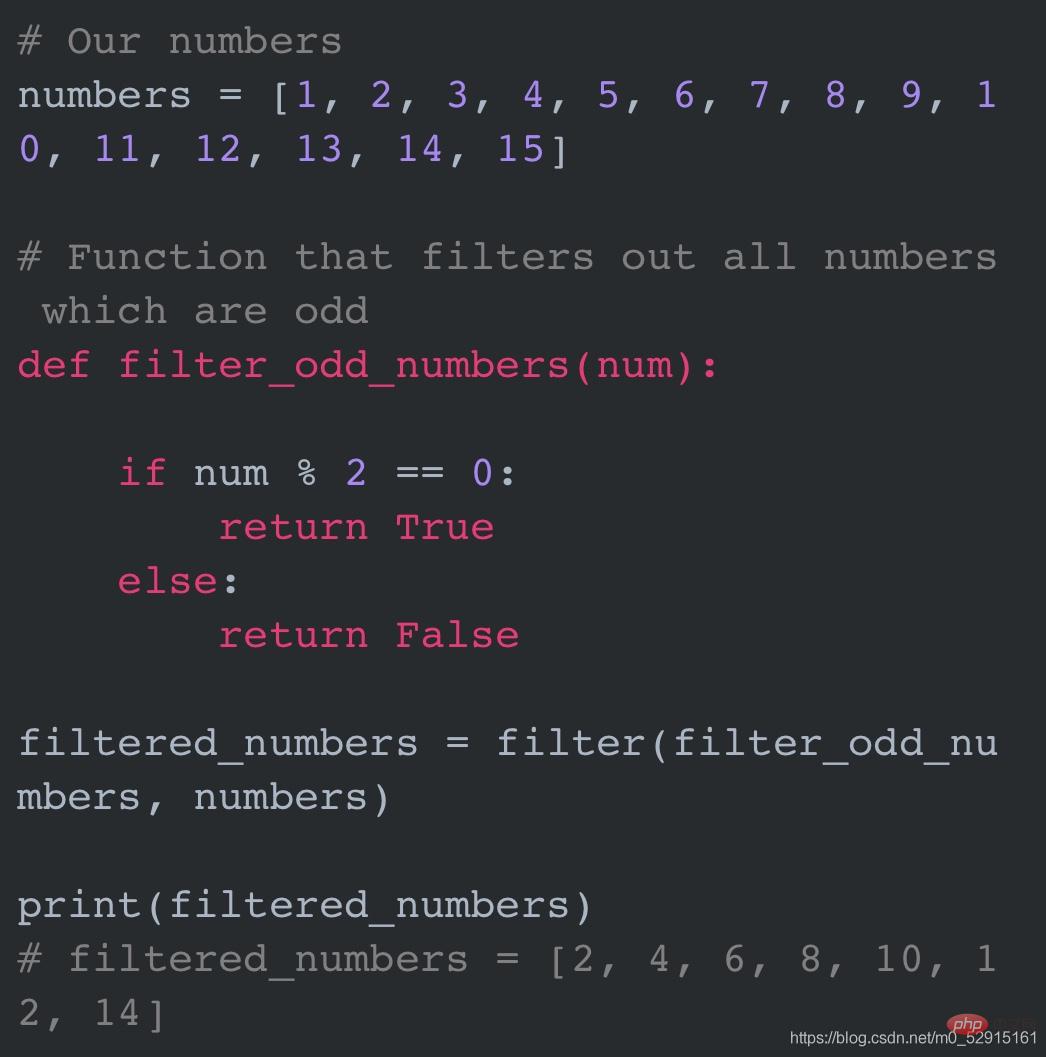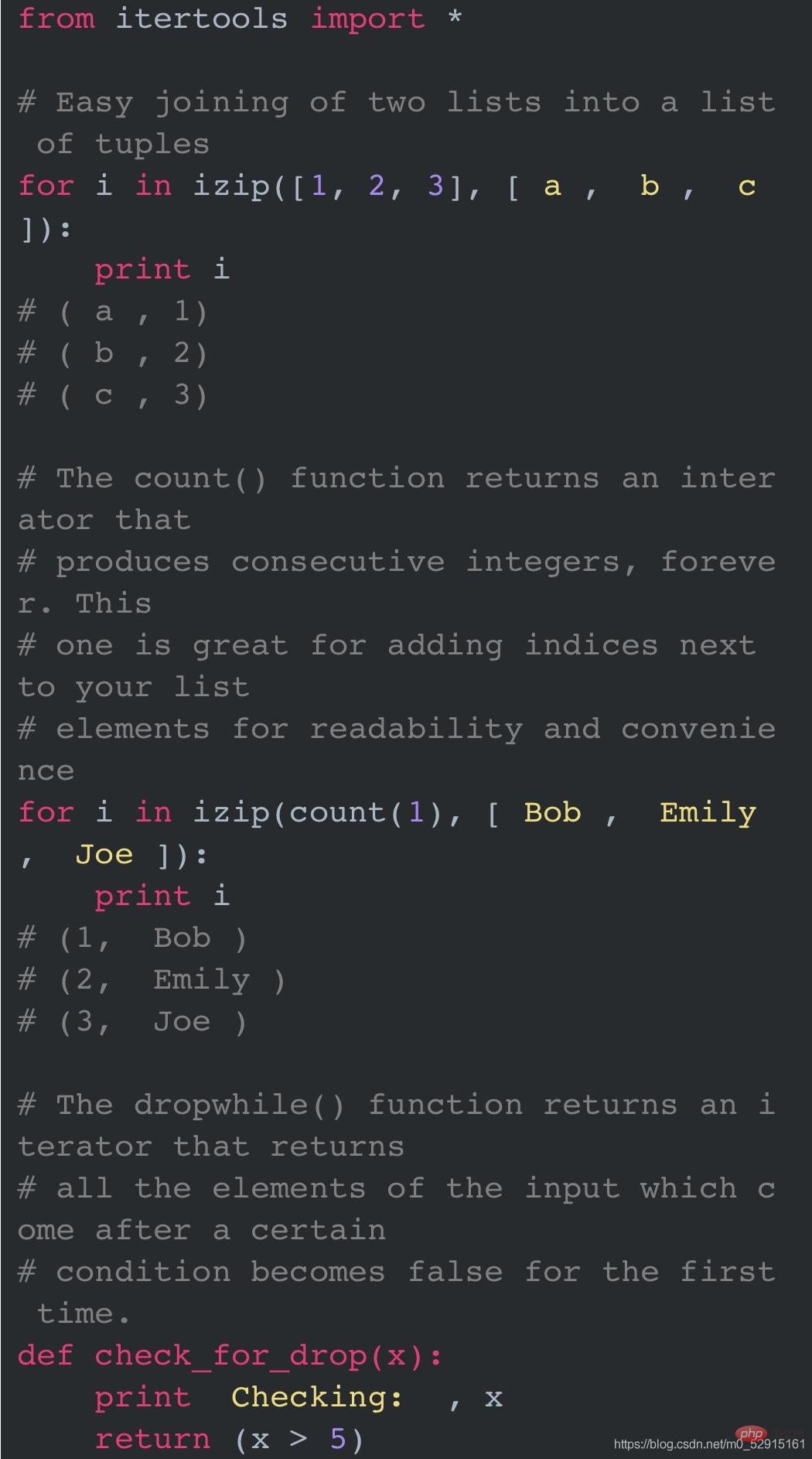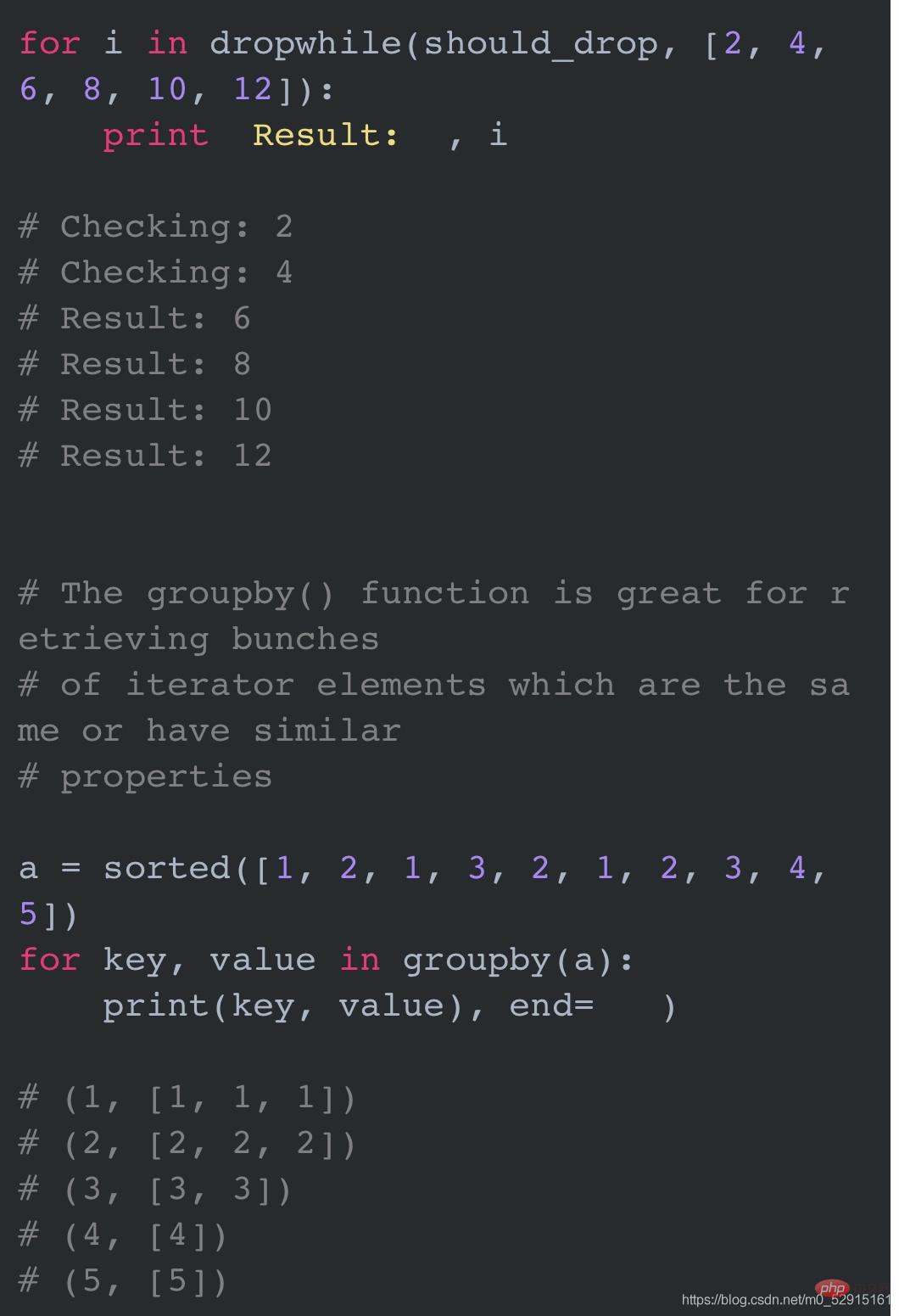5 advanced uses to improve python efficiency

Free learning recommendations: python video tutorial

Advanced features of any programming language are usually discovered through extensive experience. Let's say you're working on a complex project and looking for an answer to a question on stackoverflow. Then you suddenly discover a very elegant solution that uses Python features you never knew existed!
This way of learning is so interesting: through exploration, you discover something by accident.
Here are 5 advanced features of Python and their usage.
Lambda function
The Lambda function is a relatively small anonymous function - anonymous means that it actually has no function name.
Python functions are usually defined using the def a_function_name() style, but for the lambda function, we don’t name it at all. This is because the function of a lambda function is to perform some simple expression or operation without fully defining the function.
The lambda function can take any number of parameters, but the expression can only have one. 
Look how easy it is! We performed some simple mathematical operations without defining the entire function. This is one of the many features of Python that make it a clean, simple programming language.
Map Function
Map() is a built-in Python function that can apply functions to elements in various data structures, such as lists or dictionaries. This is a very clean and readable way to perform this operation. 
Filter Function
#The filter built-in function is very similar to the map function in that it also applies functions to sequence structures (lists, tuples, dictionaries). The key difference between the two is that filter() will only return elements for which the applied function returns True.
See the following example for details
Not only do we evaluate each list element for True or False, the filter() function also ensures that only elements matching True are returned. It is very convenient to handle the two steps of checking expressions and building return lists.
Itertools module
Python’s Itertools module is a collection of tools for working with iterators. Iterators are a data type that can be used in for loop statements, including lists, tuples, and dictionaries.
Using the functions in the Itertools module allows you to perform many iterator operations that often require multi-line functions and complex list comprehensions. Regarding the magic of Itertools, please see the following example:

Generator function
The Generator function is an iterator-like function , that is, it can also be used in for loop statements. This greatly simplifies your code and saves a lot of memory compared to a simple for loop.
For example, we want to add all the numbers from 1 to 1000. The first part of the following code block shows you how to use a for loop to perform this calculation.
If the list is small, say 1000 rows, the memory required for calculation is okay. But if the list is huge, such as one billion floating point numbers, this will cause problems. With this kind of for loop, you will have a huge list in memory, but not everyone has unlimited RAM to store that many things. The range() function in Python does the same thing, it builds a list in memory.
The second part of the code shows using the Python generator function to sum a list of numbers. The generator function creates elements and stores them in memory only when necessary, i.e. one at a time. This means that if you were to create a billion floating point numbers, you could only store them in memory one at a time! The xrange() function in Python 2.x uses a generator to build a list.
The above example illustrates: If you want to generate a list for a large range, then you need to use the generator function. This approach is especially important if you have limited memory, such as with mobile devices or edge computing.
That is, if you want to iterate over a list multiple times, and it's small enough to fit in memory, it's better to use a for loop or the range function in Python 2.x. Because the generator function and xrange function will generate new list values every time you access them, the Python 2.x range function is a static list, and the integers are already placed in memory for quick access. 
For beginners who want to learn Python development, crawler technology, Python data analysis, artificial intelligence and other technologies more easily, here is also a set of learning materials from python introduction to practice, which are available for free. .
Related free learning recommendations: python tutorial(Video)
The above is the detailed content of 5 advanced uses to improve python efficiency. For more information, please follow other related articles on the PHP Chinese website!

Hot AI Tools

Undresser.AI Undress
AI-powered app for creating realistic nude photos

AI Clothes Remover
Online AI tool for removing clothes from photos.

Undress AI Tool
Undress images for free

Clothoff.io
AI clothes remover

AI Hentai Generator
Generate AI Hentai for free.

Hot Article

Hot Tools

Notepad++7.3.1
Easy-to-use and free code editor

SublimeText3 Chinese version
Chinese version, very easy to use

Zend Studio 13.0.1
Powerful PHP integrated development environment

Dreamweaver CS6
Visual web development tools

SublimeText3 Mac version
God-level code editing software (SublimeText3)

Hot Topics
 1377
1377
 52
52
 Do mysql need to pay
Apr 08, 2025 pm 05:36 PM
Do mysql need to pay
Apr 08, 2025 pm 05:36 PM
MySQL has a free community version and a paid enterprise version. The community version can be used and modified for free, but the support is limited and is suitable for applications with low stability requirements and strong technical capabilities. The Enterprise Edition provides comprehensive commercial support for applications that require a stable, reliable, high-performance database and willing to pay for support. Factors considered when choosing a version include application criticality, budgeting, and technical skills. There is no perfect option, only the most suitable option, and you need to choose carefully according to the specific situation.
 How to use mysql after installation
Apr 08, 2025 am 11:48 AM
How to use mysql after installation
Apr 08, 2025 am 11:48 AM
The article introduces the operation of MySQL database. First, you need to install a MySQL client, such as MySQLWorkbench or command line client. 1. Use the mysql-uroot-p command to connect to the server and log in with the root account password; 2. Use CREATEDATABASE to create a database, and USE select a database; 3. Use CREATETABLE to create a table, define fields and data types; 4. Use INSERTINTO to insert data, query data, update data by UPDATE, and delete data by DELETE. Only by mastering these steps, learning to deal with common problems and optimizing database performance can you use MySQL efficiently.
 MySQL can't be installed after downloading
Apr 08, 2025 am 11:24 AM
MySQL can't be installed after downloading
Apr 08, 2025 am 11:24 AM
The main reasons for MySQL installation failure are: 1. Permission issues, you need to run as an administrator or use the sudo command; 2. Dependencies are missing, and you need to install relevant development packages; 3. Port conflicts, you need to close the program that occupies port 3306 or modify the configuration file; 4. The installation package is corrupt, you need to download and verify the integrity; 5. The environment variable is incorrectly configured, and the environment variables must be correctly configured according to the operating system. Solve these problems and carefully check each step to successfully install MySQL.
 MySQL download file is damaged and cannot be installed. Repair solution
Apr 08, 2025 am 11:21 AM
MySQL download file is damaged and cannot be installed. Repair solution
Apr 08, 2025 am 11:21 AM
MySQL download file is corrupt, what should I do? Alas, if you download MySQL, you can encounter file corruption. It’s really not easy these days! This article will talk about how to solve this problem so that everyone can avoid detours. After reading it, you can not only repair the damaged MySQL installation package, but also have a deeper understanding of the download and installation process to avoid getting stuck in the future. Let’s first talk about why downloading files is damaged. There are many reasons for this. Network problems are the culprit. Interruption in the download process and instability in the network may lead to file corruption. There is also the problem with the download source itself. The server file itself is broken, and of course it is also broken when you download it. In addition, excessive "passionate" scanning of some antivirus software may also cause file corruption. Diagnostic problem: Determine if the file is really corrupt
 How to optimize MySQL performance for high-load applications?
Apr 08, 2025 pm 06:03 PM
How to optimize MySQL performance for high-load applications?
Apr 08, 2025 pm 06:03 PM
MySQL database performance optimization guide In resource-intensive applications, MySQL database plays a crucial role and is responsible for managing massive transactions. However, as the scale of application expands, database performance bottlenecks often become a constraint. This article will explore a series of effective MySQL performance optimization strategies to ensure that your application remains efficient and responsive under high loads. We will combine actual cases to explain in-depth key technologies such as indexing, query optimization, database design and caching. 1. Database architecture design and optimized database architecture is the cornerstone of MySQL performance optimization. Here are some core principles: Selecting the right data type and selecting the smallest data type that meets the needs can not only save storage space, but also improve data processing speed.
 Does mysql need the internet
Apr 08, 2025 pm 02:18 PM
Does mysql need the internet
Apr 08, 2025 pm 02:18 PM
MySQL can run without network connections for basic data storage and management. However, network connection is required for interaction with other systems, remote access, or using advanced features such as replication and clustering. Additionally, security measures (such as firewalls), performance optimization (choose the right network connection), and data backup are critical to connecting to the Internet.
 Solutions to the service that cannot be started after MySQL installation
Apr 08, 2025 am 11:18 AM
Solutions to the service that cannot be started after MySQL installation
Apr 08, 2025 am 11:18 AM
MySQL refused to start? Don’t panic, let’s check it out! Many friends found that the service could not be started after installing MySQL, and they were so anxious! Don’t worry, this article will take you to deal with it calmly and find out the mastermind behind it! After reading it, you can not only solve this problem, but also improve your understanding of MySQL services and your ideas for troubleshooting problems, and become a more powerful database administrator! The MySQL service failed to start, and there are many reasons, ranging from simple configuration errors to complex system problems. Let’s start with the most common aspects. Basic knowledge: A brief description of the service startup process MySQL service startup. Simply put, the operating system loads MySQL-related files and then starts the MySQL daemon. This involves configuration
 How to optimize database performance after mysql installation
Apr 08, 2025 am 11:36 AM
How to optimize database performance after mysql installation
Apr 08, 2025 am 11:36 AM
MySQL performance optimization needs to start from three aspects: installation configuration, indexing and query optimization, monitoring and tuning. 1. After installation, you need to adjust the my.cnf file according to the server configuration, such as the innodb_buffer_pool_size parameter, and close query_cache_size; 2. Create a suitable index to avoid excessive indexes, and optimize query statements, such as using the EXPLAIN command to analyze the execution plan; 3. Use MySQL's own monitoring tool (SHOWPROCESSLIST, SHOWSTATUS) to monitor the database health, and regularly back up and organize the database. Only by continuously optimizing these steps can the performance of MySQL database be improved.




